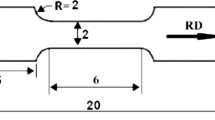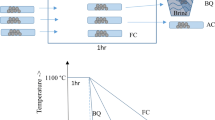Abstract
Uniaxial hot tensile tests were carried out in the RD, 45°, and TD directions of cold-rolled Ti-6Al-4V alloy sheets. At 973 K-0.1 s−1, it shows apparent mechanical and fracture anisotropy. Increasing temperature or decreasing strain rate can reduce the anisotropic behavior and significantly improve its forming quality. The SEM-EBSD result indicates that there is a T-type texture in the initial microstructure. The yield anisotropy is closely related to the distribution of the Schmid factor caused by the texture. In the RD and 45° loading paths, the Schmid factors are large, and the basal and prismatic slip is easy to be activated. It is difficult to activate these two slip systems in the TD loading direction. Under high-temperature loading conditions, the rotation of grains leads to different orientation dispersion, which further affects the phase transformation and softening behavior. The primary mechanism affecting the softening behavior is dynamic recovery (DRV). In the case of the 45° loading direction, the orientation dispersion is the largest. Its DRV and phase transformation behavior is more prominent than the other two loading directions. The loading along 45° direction has the best forming quality, and it can be selected in the processing of Ti-6Al-4V alloy.
Graphical abstract




















Similar content being viewed by others
Availability of data and materials
The data during the current study are available from the corresponding author on reasonable request.
References
Banerjee D, Williams JC (2013) Perspectives on titanium science and technology. Acta Mater 61(3):844–879
Lin YC, Tang Y, Zhang XY, Chen C, Yang H, Zhou KC (2019) Effects of solution temperature and cooling rate on microstructure and micro-hardness of a hot compressed Ti-6Al-4V alloy. Vacuum. 159:191–199.
Littlewood PD, Wilkinson AJ (2012). Geometrically necessary dislocation density distributions in cyclically deformed ti–6al–4v. Acta Materialia.
Abbasi SM, Momeni A, Lin YC, Jafarian HR (2016) Dynamic softening mechanism in ti-13v-11cr-3al beta ti alloy during hot compressive deformation. Mater Sci Eng A 665: 154–160.
Fan JK, Kou HC, Lai MJ Tang B, Chang H, Li JS (2013) Hot deformation mechanism and microstructure evolution of a new near β titanium alloy. Mater Sci Eng A 584:121–132
Balasundar I, Ravi KR, Raghu T (2017) On the high temperature deformation behaviour of titanium alloy bt3–1. Mater Sci Eng A, 684:135–145.
Ravindranadh B, Vemuri M (2018) Physically-based constitutive model for flow behavior of a ti-22al-25nb alloy at high strain rates. J Alloy Compd 762:842–848
Lee WS, Lin MT (1997) The effects of strain rate and temperature on the compressive deformation behaviour of ti-6al-4v alloy. J Mater Process Technol 71(2):235–246
Majorell A, Srivatsa S, Picu RC (2002). Mechanical behavior of ti–6al–4v at high and moderate temperatures—part i: experimental results. 326(2):297–305
Chen G, Ren C, Qin X, Li J (2015). Temperature dependent work hardening in ti–6al–4v alloy over large temperature and strain rate ranges: experiments and constitutive modeling. Mater Des 83:598–610.
Velay V, Matsumoto H, Vidal V, Chiba A (2016) Behavior modelling and microstructural evolutions of ti-6al-4v alloy under hot forming conditions. Int J Mech Sci, pp 108–109.
Ding R, Guo ZX, Wilson A (2002) Microstructural evolution of a ti–6al–4v alloy during thermomechanical processing. Mater Sci Eng A 327(2):233–245
Lee WS, Lin CF (1998) High-temperature deformation behaviour of ti6a14v alloy evaluated by high strain-rate compression tests. J Mater Process Technol 75(1–3):127–136
Lee WS, Chen TH, Huang SC (2010) Impact deformation behaviour of ti–6al–4v alloy in the low-temperature regime. J Nucl Mater 402(1):1–7
Salishchev GA, Zherebtsov SV, Malysheva S, Smyslov A, Saphin E, Izmaylova N (2008) Mechanical properties of ti–6al–4v titanium alloy with submicrocrystalline structure produced by multiaxial forging. Mater Sci Forum 584–586:783–788
Zherebtsov S, Salishchev G, Galeyev R, Maekawa K (2005) Mechanical properties of ti–6al–4v titanium alloy with submicrocrystalline structure produced by severe plastic deformation. Mater Trans 46(9):783–788
Gupta RK, Kumar VA, Mathew C, Rao GS (2016) Strain hardening of titanium alloy ti6al4v sheets with prior heat treatment and cold working. Mater Sci Eng A 662:537–550.
Guo P, Zhao Y, Zeng W, Hong Q (2013) The effect of microstructure on the mechanical properties of tc4-dt titanium alloys. Mater Eng A Struct Mater Prop Microstruct Process 563:106–111
Wahed MA, Gupta AK, Singh SK, Kotkunde N (2018) Effect of anisotropy on mechanical properties of Ti-6Al-4V in superplastic region 346:012023
Sheikh-Ali A (2007) On flow stress anisotropy in ti-6al-4v alloy sheet during superplastic deformation. J Mater Sci 42(10):3621–3626
Chen W, Boehlert CJ (2011) Texture induced anisotropy in extruded ti–6al–4v–xb alloys. Mater Charact 62(3):333–339
Yang J, Yu H, Wang Z, Zeng X (2017) Effect of crystallographic orientation on mechanical anisotropy of selective laser melted ti-6al-4v alloy. Mater Charact 127:137–145
Li PH, Guo WG, Yuan KB, Su Y, Li YP (2018) Effects of processing defects on the dynamic tensile mechanical behavior of laser-solid-formed ti-6al-4v. Mater Char, 140
Nakai M, Niinomi M, Hieda J, Cho K, Nagasawa Y, Konno T et al (2014) Reduction in anisotropy of mechanical properties of coilable (α+β)-type titanium alloy thin sheet through simple heat treatment for use in next-generation aircraft applications. Mater Sci Eng A 594:103–110.
Wang L, Zhang H, Huang G, Cao M, Cao X, Mostaed E et al (2016) Formability and anisotropy of the mechanical properties in commercially pure titanium after various routes normal and different speed rolling. J Mater Res 31(21):3372–3380
Yu W, Lv Y, Li S, Wang Y, Li B, Liao Z (2015) Mechanism of the anisotropy of yield ratio in ta5 titanium alloy plates. Mater Sci Eng A 639:314–319
Zhu Y, Tian X, Li J, Wang H (2015) The anisotropy of laser melting deposition additive manufacturing ti–6.5al–3.5mo–1.5zr–0.3si titanium alloy. Mater Des 67:538–542
A, H. Z., A, K. Z., A, H. Z., A, Z. L., B, C. Z., & B, X. Y. (2015) Effect of strain rate on microstructure evolution of a nickel-based superalloy during hot deformation—sciencedirect. Mater Des 80:51–62
Balluffi RW, Bristowe PD et al (1981) Structure of high-angle grain boundaries in metals and ceramic oxides. J Am Ceram Soc
Shi W, Yuan L, Xu F, Zheng Z, Shan D (2018) Refining whisker size of 2024al/al 18 b 4 o 33 w composite through extrusion and its effects on the material’s micro-structures and mechanical properties. Mater Charact 138:98–106
Dayananda GN, Rao MS (2008) Effect of strain rate on properties of superelastic niti thin wires. Mater Sci Eng A 486(1–2):96–103
Zaiemyekeh Z, Liaghat GH, Ahmadi H, Khan MK, Razmkhah O (2019) Effect of strain rate on deformation behavior of aluminum matrix composites with Al2O3 nanoparticles. Mater Sci Eng A 753:276–284
Barlat F, Glazov MV, Brem JC, Lege DJ (2002) A simple model for dislocation behavior, strain and strain rate hardening evolution in deforming aluminum alloys. Int J Plast 18(7):919–939
Guo WG, Nemat-Nasser S (2006) Flow stress of nitronic-50 stainless steel over a wide range of strain rates and temperatures. Mech Mater 38(11):1090–1103
Wang CJ, Deng KK, Li JC, Liang W (2018) Flow stress and deformation behavior of fine-grained mg matrix influenced by bimodal size sicp. J Mater Res 33(12):1723–1732
Stricker M, Weygand D (2015) Dislocation multiplication mechanisms—glissile junctions and their role on the plastic deformation at the microscale. Acta Mater
Benzing JT, Poling WA, Pierce DT, Bentley J, Findley KO, Raabe D et al (2018) Effects of strain rate on mechanical properties and deformation behavior of an austenitic fe-25mn-3al-3si twip-trip steel. Mater Sci Eng A 711:78–92
Han Y, Yan S, Yin B, Li H, Ran X (2018) Effects of temperature and strain rate on the dynamic recrystallization of a medium-high-carbon high-silicon bainitic steel during hot deformation. Vacuum.
Hu P, Liu Y, Zhu Y, Ying L (2016) Crystal plasticity extended models based on thermal mechanism and damage functions: application to multiscale modeling of aluminum alloy tensile behavior. Int J Plast, pp 1–25
Manikandan P, Trinadh VV, Bera S, Narasimhan TSL, Joseph M (2016) High temperature mass spectrometric studies on usbnd ga system: thermodynamic properties over (u3ga5+uga2) and (uga2+uga3) phase regions. J Nucl Mater 475:87–93
Hongmei C, Lei Z, Jianhui B (2016) The effect of grain boundary energy on the amorphous forming composition range of zr–fe–al ternary system. J Non Crystall Solids
Lin YC, Huang J, He DG, Zhang XY, Wu Q, Wang LH, Chen C, Zhou KC (2019) Phase transformation and dynamic recrystallization behaviors in a ti55511 titanium alloy during hot compression. J Alloys Comp, 795:471–482
Griffiths D (2015) Explaining texture weakening and improved formability in magnesium rare earth alloys. Mater Sci Technol 31(1):10–24
Stapleton AM, Raghunathan SL, Bantounas I et al (2008) Evolution of lattice strain in Ti–6Al–4V during tensile loading at room temperature. Acta Mater 56(20):6186–6196
Li H, Boehlert CJ, Bieler TR et al (2015) Examination of the distribution of the tensile deformation systems in tension and tension-creep of Ti-6Al-4V (wt.%) at 296 K and 728 K. Philosophical Magazine, 95(7):691–729.
Bieler TR, Semiatin SL (2002) The origins of heterogeneous deformation during primary hot working of Ti–6Al–4V[J]. Int J Plast 18(9):1165–1189
Zhang J, Di H, Wang H, Mao K, Ma T, Cao Y (2012) Hot deformation behavior of ti-15-3 titanium alloy: a study using processing maps, activation energy map, and zener–hollomon parameter map. J Mater Sci 47(9):4000–4011
Ghasemi E, Zarei-Hanzaki A, Farabi E, Tesa K, Ger AJ, Rezaee M. (2016) Flow softening and dynamic recrystallization behavior of bt9 titanium alloy: a study using process map development. J Alloys Comp, S0925838816334582.
Zheng G, Mao X, Li L, Dang R (2018) The variation of microstructures, textures and mechanical properties from edge to center in cross section of ti6242s titanium alloy. Vacuum, pp 160
Wright SI, Nowell MM, Field DP (2011) A review of strain analysis using electron backscatter diffraction. Microsc Microanal 17(3):316–329
Evers LP et al (2004) Scale dependent crystal plasticity framework with dislocation density and grain boundary effects. Int J Solids Struct 41(18–19):5209–5230
Gao H, Huang Y (2003) Geometrically necessary dislocation and size-dependent plasticity. Scripta Mater 48(2):113–118
Calcagnotto M, Ponge D, Demir E et al (2010) Orientation gradients and geometrically necessary dislocations in ultrafine grained dual-phase steels studied by 2D and 3D EBSD. Mater Sci Eng A 527(10–11):2738–2746
Acknowledgements
This work was supported by the National Natural Science Foundation of China (No.51805045) and Scientific and Technological Developing Scheme of Ji Lin Province (No. 20200401115GX)
Author information
Authors and Affiliations
Corresponding author
Additional information
Handling Editor: Naiqin Zhao.
Publisher's Note
Springer Nature remains neutral with regard to jurisdictional claims in published maps and institutional affiliations.
Rights and permissions
About this article
Cite this article
Gao, S., He, T., Li, Q. et al. Anisotropic behavior and mechanical properties of Ti-6Al-4V alloy in high temperature deformation. J Mater Sci 57, 651–670 (2022). https://doi.org/10.1007/s10853-021-06569-8
Received:
Accepted:
Published:
Issue Date:
DOI: https://doi.org/10.1007/s10853-021-06569-8




